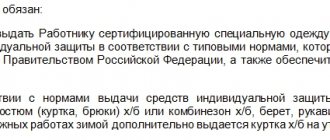What it is
Let’s agree: the time norm is Nvr, the production norm is Nvir. Standards are determined by industry orders.
There are currently 18 valid Nvyr documents for:
- geodetic and topographical works;
- mechanized field work in agriculture;
- printing production processes.
There is much more to NVR (from processing buds to programming or visiting a patient with a doctor). Most of the documents date from 1980-2000, the most recent ones were issued by the Ministry of Health (2016) and JSC Russian Railways (2014).
The procedure for developing production standards for the food industry
In catering establishments, it is customary to assume that the work of any cook is assessed in the number of dishes prepared. This approach helps to objectively assess what time, resources and labor were necessary to create a particular product. In regulatory documents for the food industry, special labor intensity coefficients have been developed, without which it is impossible to calculate the production rate.
How to calculate
Even those uniform production standards that are adopted by orders are advisory. Organizations of any form of ownership have the right (but are not obligated) to apply them. The standards detail and classify operations by level of complexity and volume per unit of time. Norms can be hourly, daily, monthly, or annual. They are calculated both for one employee and for a group (team, workshop).
In agriculture
When calculating, take into account:
- season;
- type of work (manual or mechanized);
- time spent on the preparatory stage;
- climatic features of the area;
- condition of planting (harvested) material;
- the type of roads along which goods are delivered by vehicles;
- shift duration;
- and so on.
They calculate standards using photo and video equipment: they record and study the entire working day of a certain employee (team).
In the food industry
The time spent on:
- workplace organization;
- production of one portion (piece) in relation to the norm (labor intensity coefficient);
- preliminary preparation of products (washing, cleaning);
- rest.
The formula also includes the duration of the work shift.
Let's take a closer look at what the labor intensity coefficient is. This is the ratio of time standards for preparing a dish to the time spent on preparing the dish, taken as a unit of labor intensity (conditional dish).
For example, if it takes 100 seconds to cook, the coefficient is taken as 1.
90 s - 0.9;
150 s - 1.5.
In this case, NVR is calculated on the basis of phototiming or timing.
For cleaners of industrial premises at enterprises
Here we take into account:
- preparation for the cleaning process;
- type of work and its repetition;
- type of production premises;
- floor covering;
- area of the cleaning object;
- time for personal needs;
- working hours.
Holidays: work and rest
The list of official Russian holidays is contained in Art. 112 Labor Code of the Russian Federation:
- New Year holidays and Christmas - from January 1 to January 8;
- Defender of the Fatherland Day - February 23;
- International Women's Day - March 8;
- Spring and Labor Holiday and Victory Day - May 1 and 9;
- Russia Day - June 12;
- National Unity Day - November 4.
Resolution of the Government of the Russian Federation dated July 10, 2019 No. 875 approved transfers in 2021. There are few of them:
- from January 4 (Saturday) to May 4 (Monday);
- from January 5 (Sunday) to May 5 (Tuesday).
During the five-day work week, employees will have a rest:
- from 1 (Wednesday) to 8 January (Wednesday);
- from 22 (Saturday) to 24 February (Monday);
- from 7 (Saturday) to 9 March (Monday);
- from 1 (Friday) to 5 May (Tuesday);
- from 9 (Saturday) to May 11 (Monday);
- June 12 (Friday);
- November 4 (Wednesday).
Shortened working days will be:
- April 30 (Thursday);
- May 8 (Friday);
- June 11 (Thursday);
- November 3 (Tuesday);
- December 31 (Thursday).
In 2021, employees on a five-day week will work 248 days and rest for 118.
Employees who work six days a week have noticeably fewer days off: only 66, as opposed to 300 workers. Most of the transfers will not affect them, since Saturday is not considered a day off, but a working day.
Six-day vacation schedule:
- from 1 (Wednesday) to 8 January (Wednesday);
- February 23 (Sunday) and February 24 (Monday);
- March 9 (Monday);
- from 1 (Friday) to 5 May (Tuesday);
- from 9 (Saturday) to May 11 (Monday);
- June 12 (Friday);
- November 4 (Wednesday).
For a six-day work week, shortened holidays:
- February 22 (Saturday);
- March 7 (Saturday);
- April 30 (Thursday);
- May 8 (Friday);
- June 11 (Thursday);
- November 3 (Tuesday);
- December 31 (Thursday).
On these days, the work shift is shortened by one hour.
Calculation examples
Let's calculate the production rate under different conditions, guided by the formula:
Nvr = volume of work / unit of time (e.g. pieces / minutes).
For example:
Typing text on a manual line-setting machine of the first category of complexity (minimum of foreign words, font highlighting of texts and numbers): from 1610 to 2070 characters per hour (the range depends on the number of short lines: the more there are, the higher the Nvyr; unit of change - 1000 characters, that is, Nvyr - from 1.61 to 2.07).
If Nvr is known, then the formula for the production rate is as follows: the unit of time must be divided by Nvr.
To calculate Nvr hourly: divide 60 minutes by Nvr (how long it will take to produce 1 piece of product or perform 1 operation).
For example:
NVR for typing 1000 characters - from 37.3 to 29 minutes. Divide 60 minutes by 37.3, we get 1.608; at 29 - 2.068. When rounding, we get the numbers that were higher - the Nvyr values.
Theoretical concepts
Rationing of labor is necessary in any case. How to set the salary amount for an employee? Based on what data and indicators? John Keynes first thought about this at the dawn of economic theory. Nowadays, standardization is carried out in any industry, and recommendations for this are indicated in regulatory documents.
In fact, the production rate determines how many units of output one person must make in the time allotted to him. The parameter is calculated in natural terms: ton, pieces, kilograms, meters, and so on. Despite the fact that there is a unified approach to the formation of production standards, for each sector of the economy it is completely different. At the state level, only practical recommendations are given, but specific indicators are established directly at the enterprise and are regulated by a collective agreement.
Next, we’ll look at how to calculate the production rate using the example of a specific industry.
How to use odds
Various coefficients are used in the calculations.
Thus, the coefficient of fulfillment of production standards shows whether the employee copes with the given standards (then coefficient = 1), exceeds them (coefficient > 1) or does not fully fulfill them (coefficient < 1). These data are obtained by observing labor productivity over a certain period of time and are used in further calculations. For example, to determine the optimal number of personnel.
There are coefficients that take into account conditions that complicate the task. For example, for repair work on roads with heavy traffic (it makes repairs difficult), a reduction factor of 0.83 is set for Nvir, and an increasing factor of 1.2 for NVR. Thus, on roads with heavy traffic, less work is performed per unit of time (Нвр × 0.83), and more time will have to be spent to complete a unit of work (Нвр × 1.2).
IMPORTANT!
Nvir is reduced for pregnant women (Article 254 of the Labor Code of the Russian Federation).
As the main components of the labor standardization system at an enterprise, time standards and production standards are widely used in practical work:
– to determine piece rates for payment for piece work;
– determining the number of employees;
– assessment of performance indicators of performers;
– calculation of planned indicators for the wage fund;
– determining the labor intensity of products (works, services);
– economic justification for the use of new equipment and technology;
– solving other problems.
Document: Methodological recommendations for establishing norms and standards for rationing the work of workers, approved by Resolution of the Ministry of Labor and Social Protection of the Republic of Belarus dated November 26, 2004 No. 134.
Methodological Recommendations No. 134 provide definitions of time standards and production standards.
Standardizing the work of key workers on the basis of time standards is advisable in cases where the workplace does not have a constant load and (or) various operations are performed on it during the shift.
For auxiliary workers, labor standardization using time standards is advisable when the work performed is homogeneous in nature and its content, volume and methods of performing work are strictly defined.
For reference: standard time is the amount of working time established to perform a unit of work by one employee or a group of employees of appropriate qualifications in certain organizational and technical conditions.
The production rate is set for work with greater repetition during a shift at the workplace. To standardize the labor of key workers, it is used in cases where the same work (operation) is performed during a work shift with a constant composition of performers. To standardize the work of auxiliary workers, the use of production standards is advisable if they are assigned a certain job that is part of the structure of the production process, and the content, volume and methods of its implementation are strictly regulated.
The production rate is determined by the formula
where Nvyr is the current production rate;
T – duration of working time: hour, shift, month, year;
Nvr – standard time per unit of product or work.
The production rate can be determined in various natural units: meters, tons, pieces, etc.
Time norm and production norm are reciprocal quantities
There is an inverse relationship between the time norm and the production norm, which is expressed by the following formulas:
Example 1
The standard time for manufacturing a product is 0.25 standard hours. Let's find the production rate as the reciprocal of the time rate using formula 2:
The production rate is 4 pcs. in an hour.
And vice versa, if the production rate is known (Nvyr = 4 pcs./h), then the time rate will be determined using formula 3:
For reference: production norm is a set volume of work (number of units of production) that an employee or group of workers of appropriate qualifications is required to perform (manufacture, transport) per unit of working time under certain organizational and technical conditions.
Calculation of standard output
Based on the standard time per unit of production (work) and the estimated number of working hours in the time period, the standard output of the worker is determined.
Example 2
A worker produces part M-1 in a 5-day, 40-hour workweek. Estimated standard working time: 8-hour shift, average monthly - 167.3, annual - 2,008. The standard time for manufacturing a part is 0.33 standard hours. Production rates for time periods are characterized by the data presented in table. 1.
Table 1
Application of the time standard for calculating standard production
Determination of piece rates
Time standards and production standards are used to determine prices for piecework wages. The following formulas are used:
or
where P – piece rate;
C – hourly tariff rate.
For reference: the piece rate is determined by dividing the hourly tariff rate corresponding to the category of work performed by the hourly production rate or by multiplying the hourly tariff rate by the established time standard in hours (part two of Article 88 of the Labor Code of the Republic of Belarus; hereinafter referred to as the Labor Code).
Example 3
Based on the data in example 2, the standard time for manufacturing a part is 0.33 standard hours, the hourly production rate is 3.03 units. The work is charged at the 5th category. The hourly tariff rate of the 5th category is 18,000 rubles. Let's determine the piece rate in two ways, i.e. according to formulas 4 and 5 (see Table 2).
Naturally, in both cases the same piece rate will be received.
Time standards and production standards: how do they influence each other?
As we already know, there is an inverse relationship between the production rate and the time rate. Let's look at what this looks like in practice.
Example 4 (increasing production rate)
As a result of the implementation of measures to improve labor organization, the current production standard for the manufacture of a product was increased from 4 to 5 pieces. at one o'clock.
Using formula 3, we determine the time standard according to the production rate valid before the implementation of measures to improve labor organization:
After the implementation of the event, the time standard will be equal to:
As a result of improving labor organization, the standard time decreased from 0.25 to 0.2 standard hours.
Important! When the production rate increases, the time rate decreases, and vice versa, when the production rate decreases, the time rate increases.
Example 5 (reduction in production rate)
According to the employer's order, the production rate for a young shoe assembler working on a device for attaching heels to the heels of women's shoes was reduced from 12 pairs per hour to 10 pairs per hour.
Time standards for performing the operation per 1 pair of shoes will be:
– before the production rate decreases:
– after reducing the production rate:
Thus, for a young worker, a decrease in the established production rate led to an increase in the time rate from 0.08 to 0.10 standard hours per pair of shoes.
Important! As the time standard increases, the production rate decreases; When the time standard decreases, the production rate increases.
Example 6 (increasing the time limit)
In order to reduce the production rate, the employer increased the time limit for a worker who graduated from a secondary school to weed flower beds when they are heavily infested from 0.095 to 0.11 person-hour per 1 m2.
The production standards will be:
– before increasing the time limit:
Nvyr = 1 / 0.095 = 10.5 m2/h;
– after increasing the time limit:
Nvyr = 1 / 0.11 = 9.1 m2/h.
Example 7 (reduced time standard)
Measures to introduce the new technology provide for a reduction in the brigade time standard for the production of 1 ton of products from 0.45 standard hours to 0.4 standard hours.
Let's calculate the current brigade production rate per shift (see):
– before implementing measures:
Nvyr = 8 h / Nvr = 8 / 0.45 = 17.8 t/cm;
– after the implementation of measures:
Nvyr = 8 h / Nvr = 8 / 0.4 = 20 t/cm.
As a result of measures to introduce the new technology, the standard time was reduced from 0.45 standard hours to 0.4 standard hours, and the standard output increased from 17.8 to 20 tons per shift.
Often, an increase or decrease in production standards and time standards is specified not in natural numbers, but as a percentage of the existing value. We will consider below how the inverse relationship between these quantities manifests itself in such cases.
Determining the percentage increase in the production rate with a known percentage reduction in the time rate
The percentage of increase in the production rate with a known percentage of reduction in the time rate is determined by the formula
where Pp.n.vyr is the percentage increase in the production rate;
Ps.n.vr – percentage reduction in the time norm.
Example 8
Automation of the production process made it possible to reduce the time required to manufacture a product by 40%. Let us determine by what percentage the production rate has increased.
Let's calculate the percentage increase in the production rate of products as a result of automation of the production process using formula 6:
Determining the percentage reduction in the production rate with a known percentage increase in the time rate
The percentage of reduction in the production rate with a known percentage increase in the time rate is determined by the formula
where Ps.n.vyr is the percentage of reduction in the production rate;
Pp.n.vr – percentage increase in time standard.
Example 9
As a result of transferring the process of painting window blocks from the factory to the construction site, the time standard was increased by 16%. It is necessary to determine by what percentage the production rate has decreased.
Let's calculate the percentage reduction in the production rate of window units with the same number of personnel using formula 7:
Determining the percentage increase in the time norm with a known percentage decrease in the production norm
The percentage of increase in the time norm with a known percentage of decrease in the production norm is determined by the formula
Example 10
As a result of transferring the process of painting window blocks from the factory to the construction site, the production rate decreased by 13.8%. Let us determine by what percentage the standard time has increased.
The percentage increase in the time standard for painting a window block will be calculated using formula 8:
Determination of the percentage reduction in the time norm with a known percentage increase in the production norm
The percentage of reduction in the time norm with a known percentage increase in the production norm is calculated using the formula
Example 11
Increasing the level of cooperation makes it possible to increase the standard output of a production unit by 12%. It is necessary to calculate by what percentage the standard production time of the product will be reduced.
The percentage reduction in the standard time for manufacturing a product is determined by formula 9:
Situations when production standards need to be reduced
Labor legislation provides for cases where certain categories of workers may have their production standards reduced (see Table 3).
The size of the reduction in production standards and their duration are determined in the collective agreement, order of the employer, or employment contract. A reduction in production standards for a worker with piecework wages means an increase in the time standard and is accompanied by an increase in piecework rates.
Let's consider a situation where labor rationing is carried out on the basis of production norms.
If the standardization of labor and the determination of piece rates are based on production standards, then after its reduction, the new production rate is determined by the formula
where Nvyr.sn is the production rate after its reduction;
Psn – percentage reduction in production.
The recalculation of the piece rate is due to the use in formula 4 of the reduced value of the production rate (Nvyr.sn):
P = C / Nvyr.sn.
Example 12
The hourly wage rate for a green construction worker of the 5th category, who is a disabled person of group II, is 18,650 rubles. According to the Norms of labor costs for construction, installation and repair work (hereinafter referred to as NZT), collection No. 18, code 18-318, the hourly production rate for the formation of the crown of shrubs with a bush diameter of up to 0.5 m is 22.7 bushes (1 / 0.044 or 182 / 8). The piece rate per bush is:
R = 18,650 / 22.7 = 822 rubles.
The employer, taking into account the worker’s health, reduced his production rate by 20%. The reduced production rate will be:
Nvyr.sn = 22.7 – (22.7 × 20 / 100) = 18.16 bush.
After recalculation, the piece rate will be equal to:
R = 18,650 / 18.16 = 1,027 rubles.
If labor standardization is carried out on the basis of time standards and tables of local, industry or inter-industry time standards are used as initial standards, then to establish piece rates it is necessary to determine the production rate based on the applied values of time standards. Further, the sequence of calculations is similar to that given in example 12, i.e. First, the reduced production rate is determined, and then the piece rate, calculated on the basis of the reduced production rate.
The percentage of compliance with standards is the most important indicator of standardization
The percentage of fulfillment of production (time) standards is the main assessment indicator of the productivity of workers with piecework wages. This indicator is often used in systems of current bonuses, material and moral incentives for workers, in production competition between teams, production units, and also to assess the state of labor regulation. The percentage of fulfillment of production (time) standards is also necessary for the implementation of the provisions of Art. 71 TK.
For reference: in case of failure to meet production standards, defects and idle time not due to the fault of the employee, the wage cannot be lower than 2/3 of the tariff rate (salary) established for him. If production standards are not met due to the fault of the employee, payment is made for the work actually performed (Article 71 of the Labor Code).
The percentage of standards fulfilled can be determined both by time standards and by production standards. When determining the percentage of fulfillment of standards according to time standards, all work performed by one worker or their group, expressed in standard hours, should be attributed to the actual time worked in man-hours and multiplied by 100:
where Mon is the percentage of compliance with standards;
Tn – standard time, normo-h;
Tf – actual time worked, hours.
In turn, the standard time is calculated according to the formula
where q is the number of units actually produced;
tн – standard time per unit of production, standard hours.
Example 13
In August 2013, the site produced:
– products of group A in the amount of 100 units. with a standard time per unit of production of 2 standard hours;
– products of group B – 150 units. with a time standard of 2.5 standard hours;
– products of group C – 200 units. with a time standard of 3 standard hours.
Actually worked 1,000 man-hours.
The percentage of compliance with the standards will be:
Mon = (100 × 2 + 150 × 2.5 + 200 × 3) / 1,000 × 100 = 117.5%.
When determining the percentage of compliance with production standards, it is necessary to refer the volume of work actually performed, expressed in physical units of measurement, to the normative one, calculated on the basis of the current production norm, and multiply by 100:
where Pvyr is the percentage of compliance with production standards;
Of – the volume of work actually performed;
It is the standard amount of work performed.
Example 14
According to the current company bonus conditions for mason workers, if production standards are met by 100% or more during the reporting period, they are paid a bonus of 40%. In August 2013, a team of masons, consisting of 2 workers, worked for 22 days and produced 125 m3 of brickwork of walls of medium complexity, 2 bricks thick. According to NZT, collection No. 3, with the specified wall construction, the replacement production rate is 2.5 m3. Let's find out whether the masons' link fulfilled the bonus conditions.
To do this, we determine the standard output volume of 2 workers in 22 working days using the formula
where Osmn is the shift production rate for one worker, m3;
Kd – the number of working days worked;
N – number of workers, people.
Substituting the initial data into formula 14, we get:
It = 2.5 × 22 × 2 = 110 m3.
Let's determine the percentage of compliance with the norms using formula 13:
Pvyr = 125 / 110 × 100 = 113.6%.
Thus, in August 2013, the masonry team fulfilled the bonus condition, ensuring the fulfillment of production standards by 113.6%, and the corresponding bonus amount was awarded to them.
Production rate and headcount standard
The production rate is a fixed amount of work (for example, the number of units of goods) that a worker or group of workers with a certain level of qualifications must carry out (produce) per unit of labor time under the established conditions for organizing the work process. The production rate is considered a derivative of the time rate and is determined by dividing the working time of workers during the accounting period by the time rate.
The headcount standard is an established calculated value, represented by the number of workers that can be kept to work at a specific facility to implement a specific volume of work.
Standard working hours
What is the normal working time per week can be calculated based on Art. 91 TK. This legislative act defines the work standard of forty hours per week. Respectively:
- (40 * 4) 160 standard working hours per month;
- (40 / 5) 8 hours per day.
What you should know
You should distinguish between employee overtime, which is considered overtime work, and irregular working hours. An irregular working day according to the Labor Code of the Russian Federation is a special work schedule provided for in an employment contract, which already includes occasional cases of overtime. These overtimes are not paid additionally by the employer.
All organizations must adhere to the current standard. Whether it is budgetary or private does not matter. A person has every right to work for a shorter amount of time by agreement with the employer. The company must pay additionally for processing. For example, a worker and an employer agree to go to work on certain days more than usual. Then, according to Art. No. 152, overtime is paid at least 1.5 times the first two hours, and 2 times the subsequent time. A person has the right to replace individual payment with compensation in the form of an additional day off. In simple terms it is called time off. How to write an application for time off, read the article https://otdelkadrov.online/9994-rekomendatsii-po-sostavleniyu-podache-zayavleniya-na-otgul.
Based on Art. No. 97, No. 99 Labor Code can be established, the duration of processing cannot be longer:
- 4 hours for two days in a row;
- one hundred and twenty hours per year.
Enterprises have an obligation to keep accurate records of the working hours of their entire workforce.
General requirements for production workshops before starting cleaning
The above production standards will make sense if a number of requirements for production premises are met. As we understand, in a workshop where work is in full swing all day, everything must be in order by the end of the shift. This time is taken into account by the worker standing at the machine, and not by the cleaning lady. So, here are the general requirements for production premises:
- At the entrance there must be special floor gratings or mats that collect dirt from the street;
- floors must be promptly repaired when cracks and potholes appear;
- all transport carts must have rubber wheels that do not damage the floor;
- the walls must be made in accordance with the standards adopted by government services (painted or covered with light tiles);
- garbage and broken containers must be removed by the employee into appropriate containers;
- special attention is paid to the distance standards between equipment;
- All employees must maintain their work area and keep it clean.










